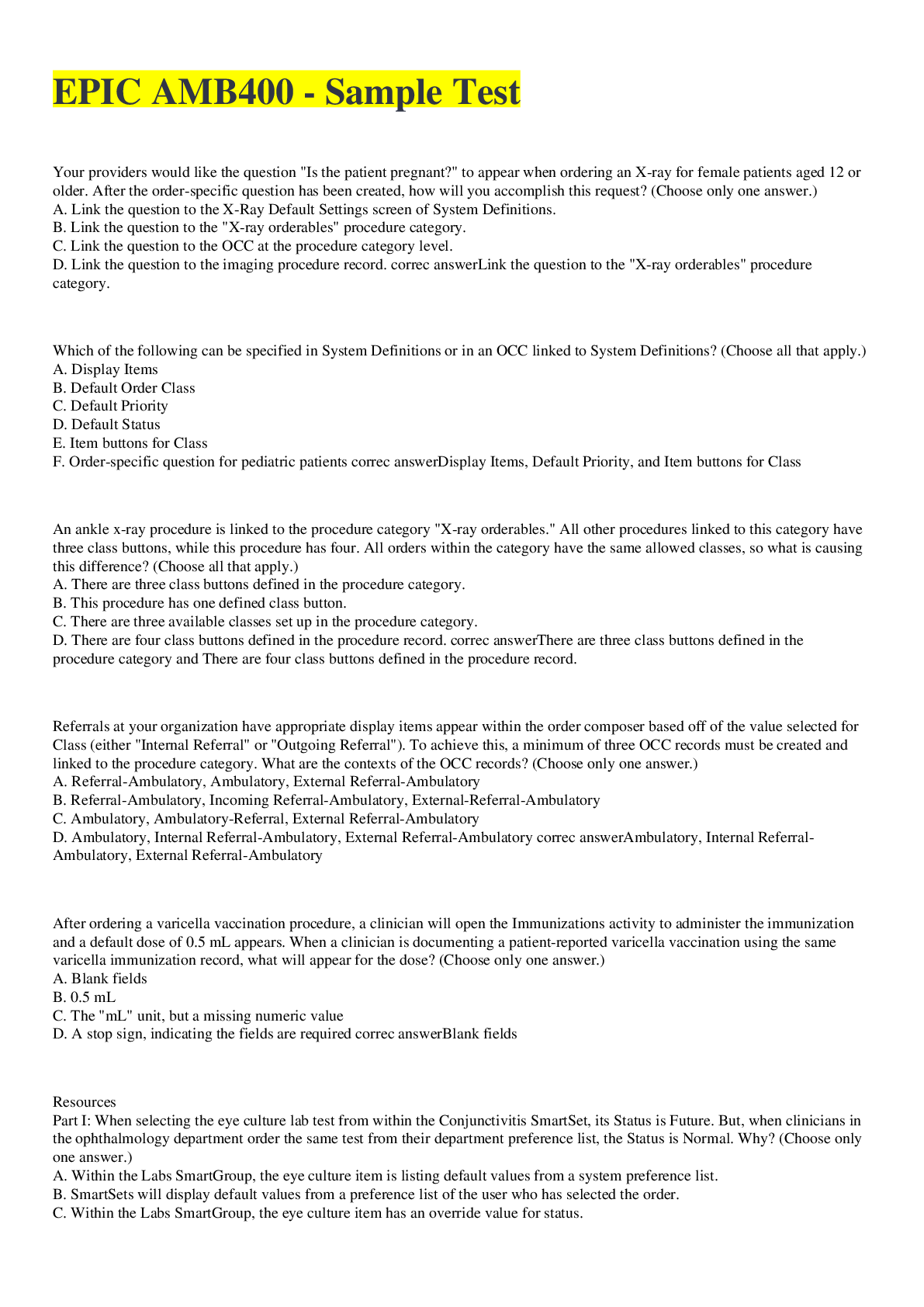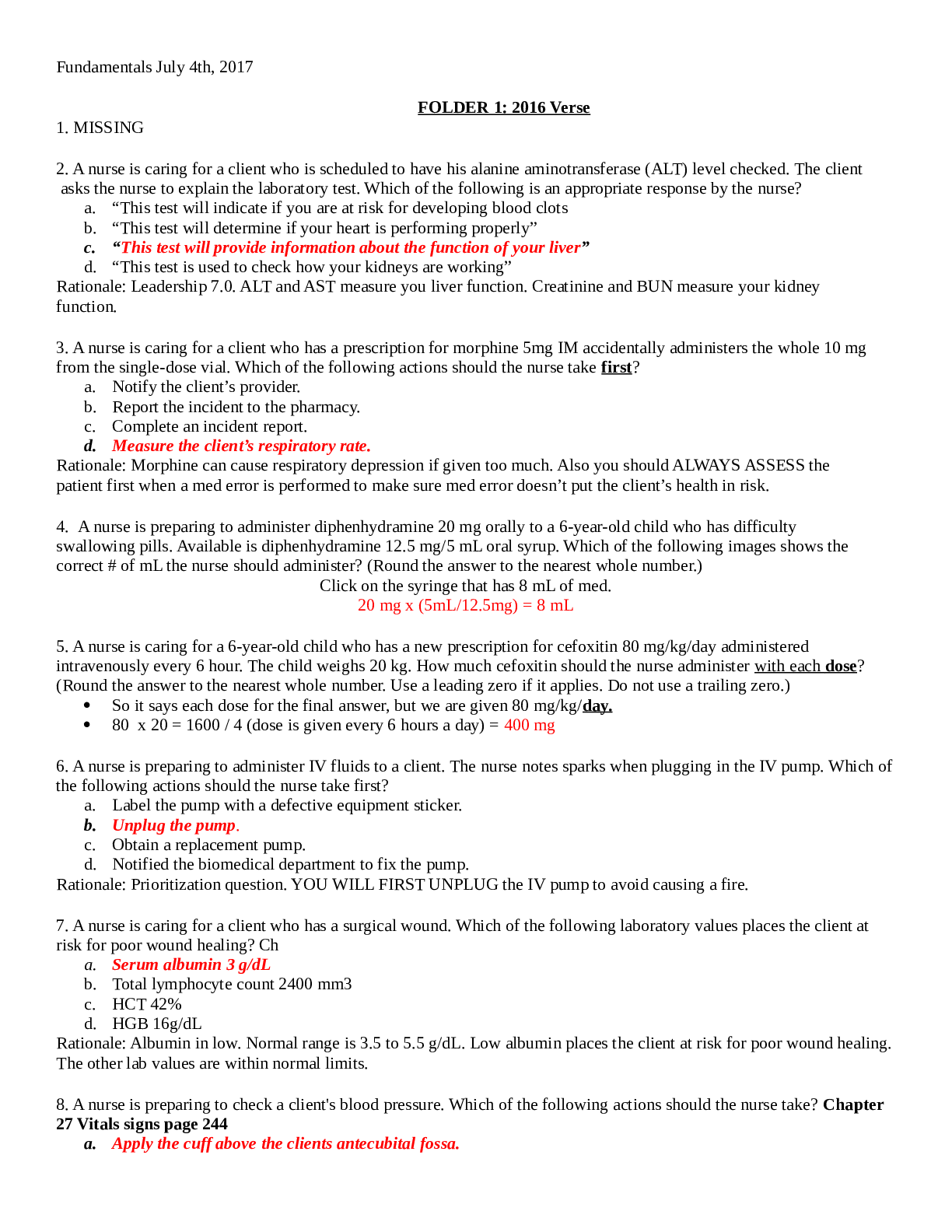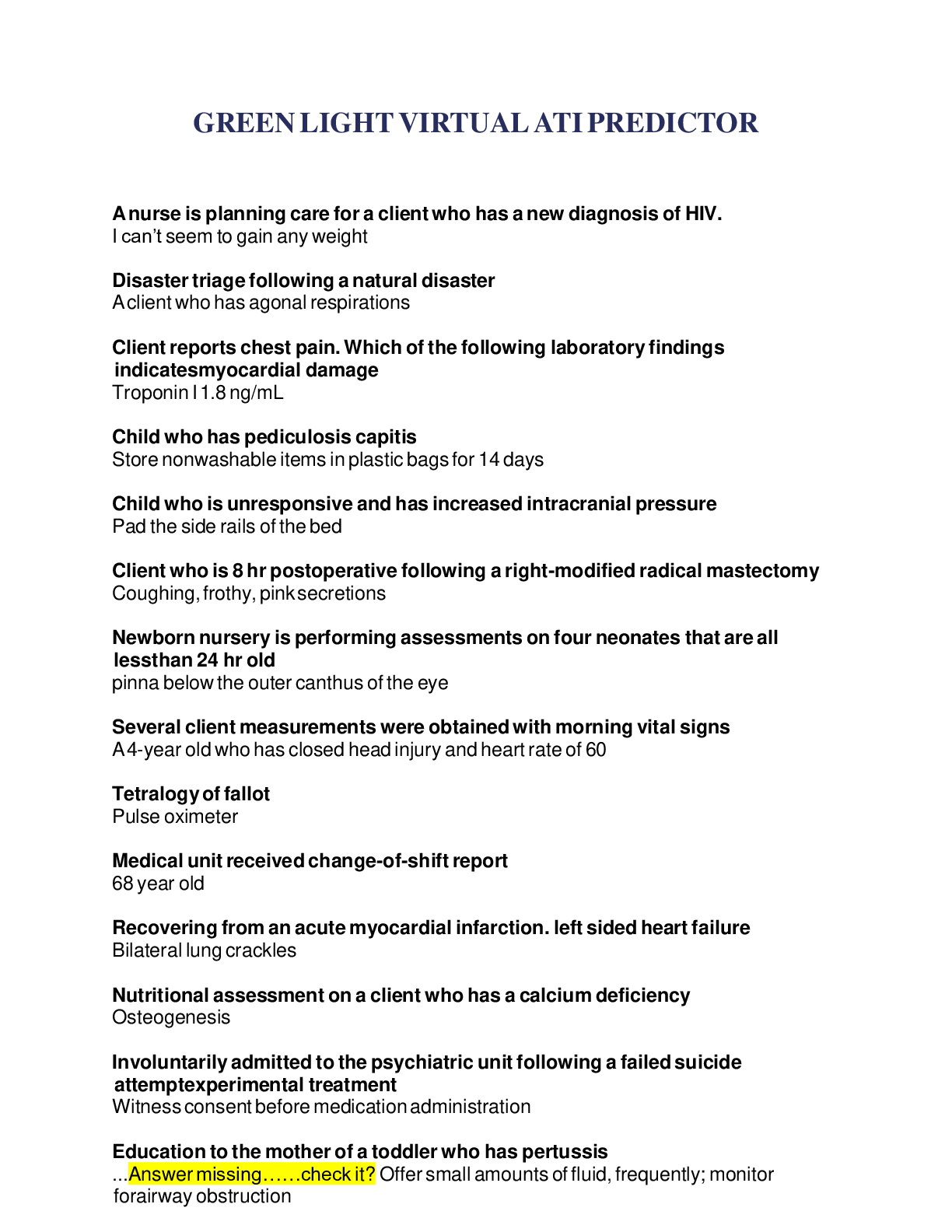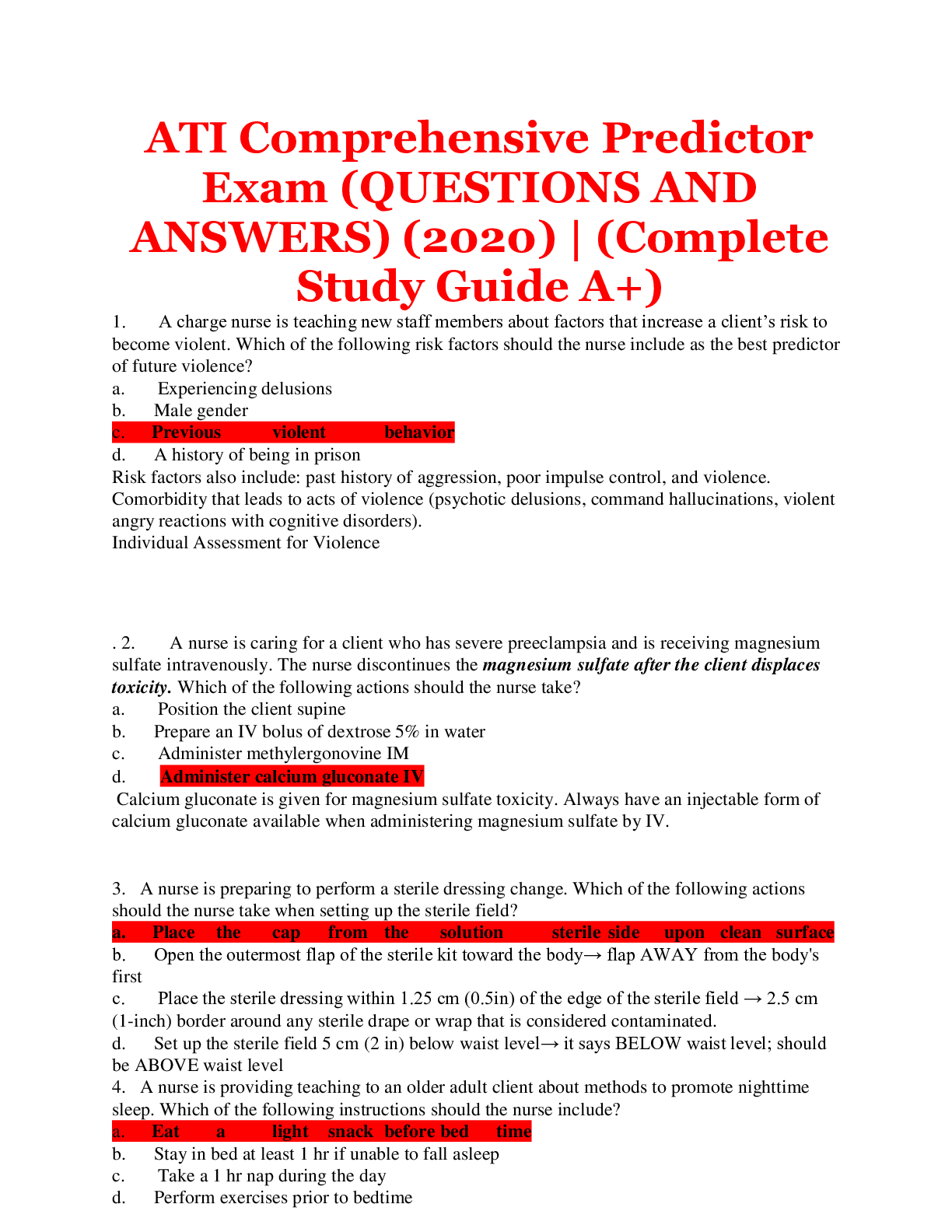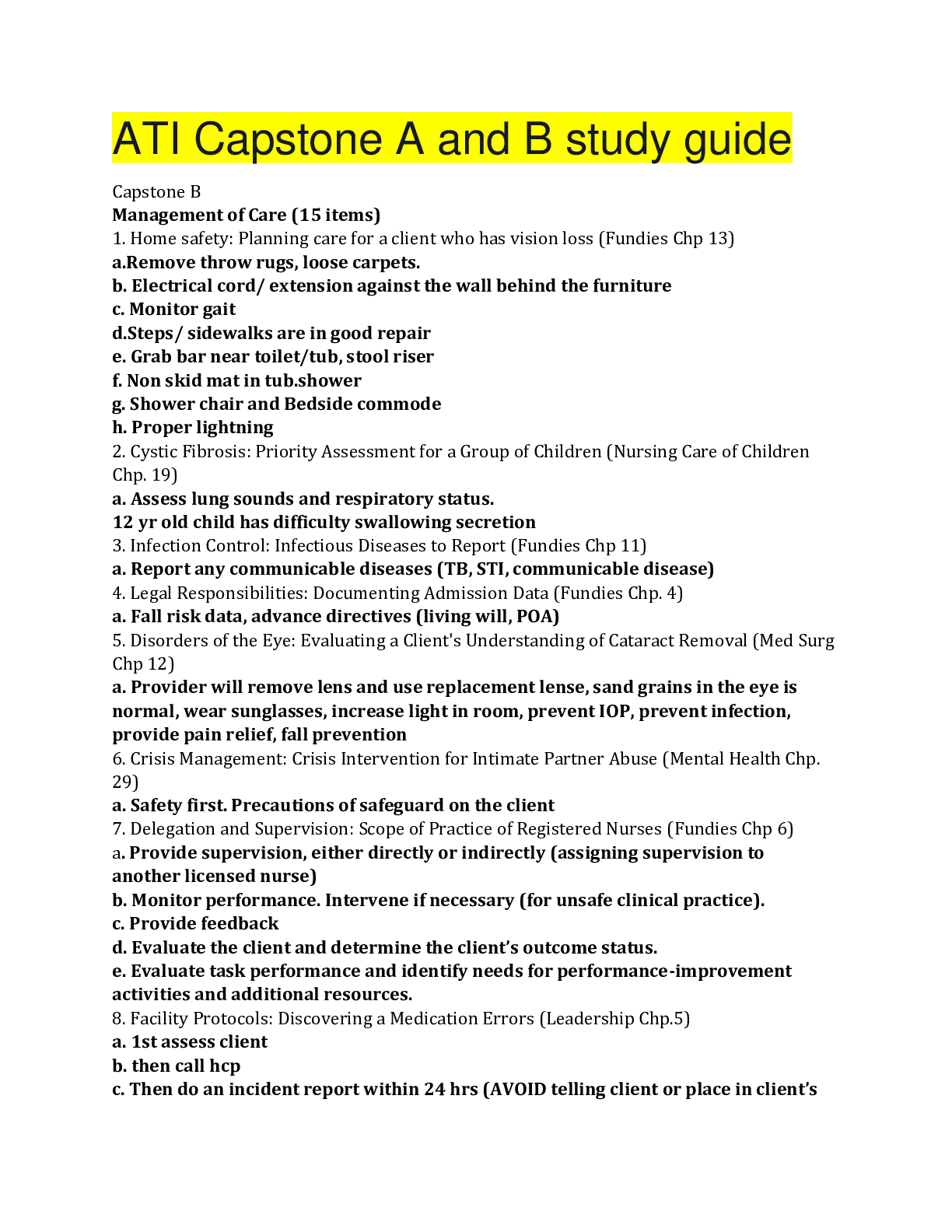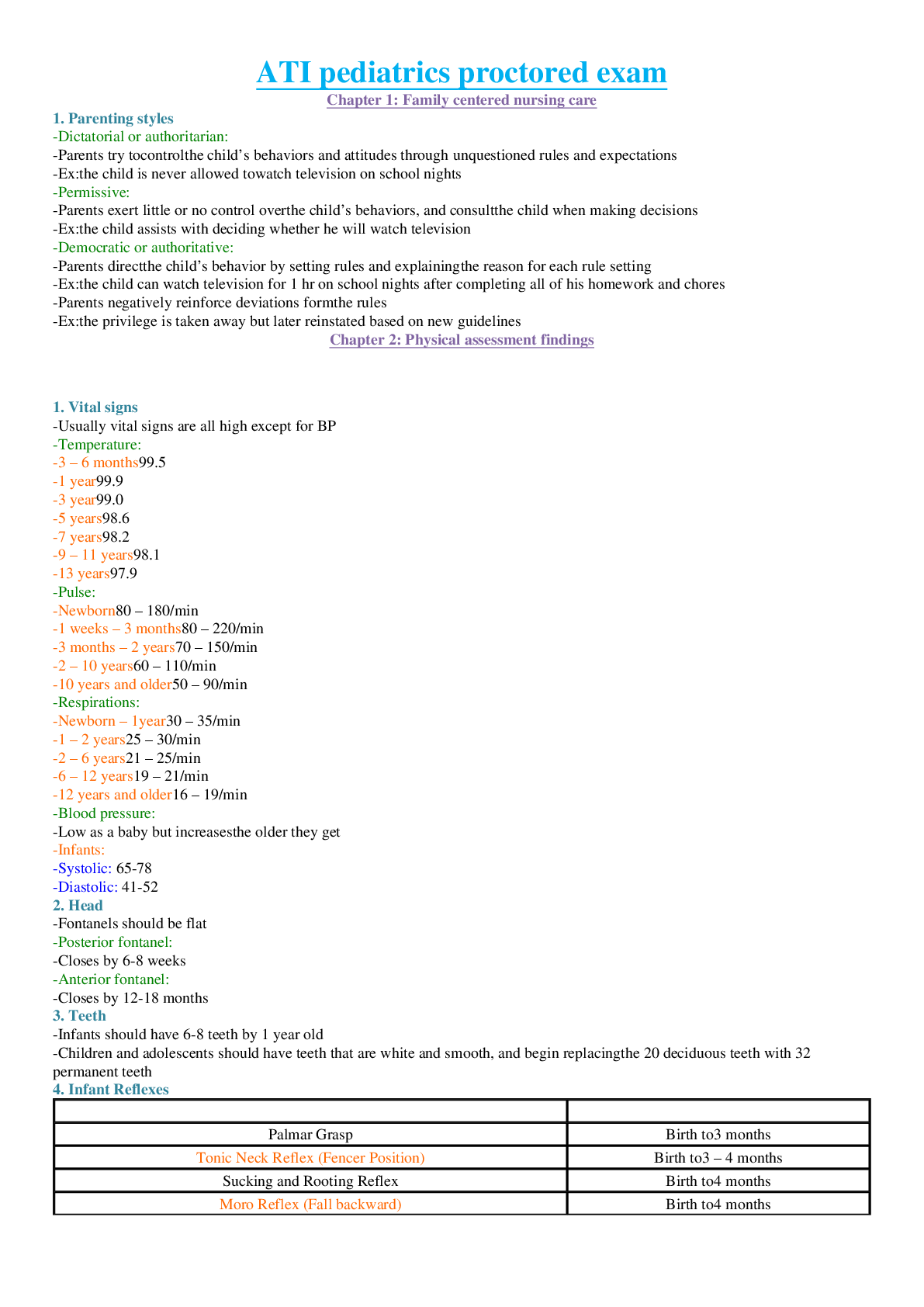Social Sciences > QUESTIONS and ANSWERS > CAI Exam -study Guide with complete solution Graded A+ (All)
CAI Exam -study Guide with complete solution Graded A+
Document Content and Description Below
Community Association - ANSWER legal entity in which the owners enjoy the protection, enhancement, maintenance and preservation of their homes and property. What're the three defining characteristi... cs of community associations? - ANSWER 1. Membership in the community association is mandatory and automatic for all owners 2. Certain association governing documents bind the owner and the association to each other through mandated actions. 3. Mandatory lien-based assessments (maintenance fees) are levied on each owner in order to operate and maintain the community association. What is a lien? - ANSWER legal claim by one party (community association) on the property of another (delinquent owner) to obtain the payment of a debt or the satisfaction of an obligation. What is the primary purpose of a community association? - ANSWER Purpose is to provide for the community, business, and governance aspects of the association. This is done by administering, maintaining, and enhancing a residential real estate development, and through the establishment of a system of property rights, binding covenants and restrictions, and rules and regulations. What're the 3 types of basic residential community associations? - ANSWER 1. Planned Community 2. Condominium 3. Cooperative What is a planned community? - ANSWER Owner owns his or her own long and/or living unit The community owns any common areas, such as tennis courts and roads for the use and benefit of the lot owners. What is a condominium? - ANSWER The individual owns his or her living unit and an undivided interest in the common elements of the community. Each owner owns a percentage of the common elements - which consist of everything except the living units, ex. pool or lobby. The community association itself owns no real estate as an association. What is a cooperative association? - ANSWER An individual owns stock or membership in the cooperative and holds a proprietary lease or occupancy agreement for his or her living unit. What is a proprietary lease or occupancy agreement? - ANSWER defines the member or stockholder's rights and obligations in relation to the living unit. The 3 types of residential community associations can exist by themselves or they can be grouped in clusters called: - ANSWER 1. Master or umbrella associations 2. Mixed-use developments 3. "55 and Older" Communities What is a Master or Umbrella Association? - ANSWER A master or umbrella association consists of more than one residential community association. What is a Mixed-Use Development? - ANSWER A mixed-use development usually consists of a mixture of residential and commercial and/or industrial uses group together. Their marketing slogan is often "live, work, play". What is a "55 and Older" Community? - ANSWER Must have one person who is 55 years of age or older living in at least 80% of its occupied units. What is the Equal Employment Opportunity Commission (EEOC)? - ANSWER The federal government prohibits discrimination against otherwise qualified people in hiring, promotion, dismissal, compensation, and working conditions based on specific personal characteristics including: -race and ethnicity -color -national origin -age -gender -religion -pregnancy -disability What is the Fair Debt Collection Practices Act (FDCPA)? - ANSWER The purpose of the FDCPA is to protect debtors from unscrupulous debt collectors and to impose a consistent and fair method to collect debts. What is the Fair Labor and Standards Act (FSLA)? - ANSWER FLSA dictates standards for the basic minimum wage and overtime pay. It affects most private and public employment. It requires employers to pay covered employees who are not otherwise exempt at least the federal minimum wage and overtime pay of one-and-one-half-times the regular rate of pay. Some states have higher basic minimum wage amounts. What is the Family and Medical Leave Act (FMLA)? - ANSWER Administered by the Wage and Hour Division of the Department of Labor, FMLA requires employers of 50 or more employees to provide up to 12 weeks of unpaid, job-protected leave to eligible employees for the birth or adoption of a child or for the serious illness of the employee or a spouse, child, or parent. What is the Federal Insurance Contributions Act (FICA)? - ANSWER This act requires employers and employees to make matching contributions to Social Security. The employer must withhold the employee's share of the tax from his or her wages or salary and pay it timely to the federal government. What is the Occupational Safety and Health Act (OSHA)? - ANSWER OSHA's mission is to "prevent injuries and protect the health of America's workers by ensuring safe and healthful workplaces". Some OSHA requirements include: -specific working conditions - What is the Soldiers' and Sailors' Civil Relief Act of 1940? (SSCRA) - ANSWER SSCRA impacts American forces on active duty by requiring the delay of all civil court actions, such as bankruptcy or foreclosure, until the service member returns from active duty. SSCRA also protects active service members' dependents from being evicted if the rent does not exceed $1,200 per month by requiring the landlord to obtain a court order authorizing eviction. What is the U.S. Bankruptcy Code? - ANSWER The purpose of this law is to help honest people and businesses find a way to pay their debt or get a fresh law. These laws help people who can no longer pay their creditors start anew -- by liquidating assets to pay their debts or by creating a repayment plan. Bankruptcy Prevention and Consumer Protection Act (2005) contained a small provision stating that associations have the authority to collect assessments that come due after the date the homeowner filed for bankruptcy. What is the Federal Communications Commission? (FCC) - ANSWER In 1996, FCC adopted the Over-The-Air Reception Devices (OTARD) Rule concerning restrictions on viewers' ability to view programming from direct broadcast satellites, wireless cable and television broadcast stations. This overrides the association's deed restriction that bans satellite dishes and antennae from property that is exclusively used, controlled or owned by the resident, including tenants. What is the Fair Housing Act? - ANSWER This prohibits the discrimination in the sale, rental, financing, insuring and other housing related services of dwellings based on race, color, religion, or national origin. In "55 and Older" communities: - ANSWER There must be one person who is 55 years of age or older living in at least 80% of its occupied units. What are the three types of State Statutes? - ANSWER 1. General State Statutes 2. Specific State Statutes 3. Uniform State Statutes What is a General State Statute? - ANSWER This generally applies to community associations, as well as other types of organizations. The statute most often applied to community associations are the regular corporate or the not-for-profit corporate statutes. What is a Specific State Statute? - ANSWER This applies to one or more types of community associations. Ex: all states have a condominium act which provides for the establishment and operation of condominiums as legal entities. The simplest ones just allow for the creation of condominiums, while others go into great detail dictating what the condominium association must do and not do for its members, including the specific process for enforcing the government documents. A Specific State Statute for a certain type of community association takes precedence over any General State Statute that applies to the community association. True or False? - ANSWER True What is a Uniform State Statute? - ANSWER National Conference of Commissioners on Uniform State Laws draft generic, content-specific wording for topical issues to encourage uniformity among the states. What is the purpose of the governing documents? - ANSWER To provide the legal structure and operation of the community. The governing documents: - ANSWER -Define the rights and obligations of both the community association and its owners. -Create a binding relationship between each owner and the community association. -Establish the mechanisms for governing and funding the community association's operations, including the establishments of the automatic lien. The governing documents set forth rules and restrictions for: - ANSWER -Protection of both owners and the community -Enhancement of property values -Promotion of harmonious living For operating a community association, what is the general hierarchy of authority among governing documents? - ANSWER 1. Recorded map, plat, or plan 2. Declaration, CC&Rs, Master Deed 3. Proprietary lease or occupancy agreement 4. Articles of Incorporation 5. Bylaws 6. Board Resolutions - these cannot conflict with documents above it in the hierarchy What is a recorded map, plat, or plan? - ANSWER This is recorded before the first parcel sold/title transferred. The plat sets development's boundaries. The Declaration, Master Deed, or CC&Rs generally (1-3): - ANSWER 1. Define portions of the development owned by the individual owners and those owned by the community association 2. Creates interlocking relationships binding all the owners to one another governing, and funding the development 3. Establishes standards, restrictions, and obligations in areas ranging from architectural control to prohibitions on various activities in order to promote harmonious living. The Declaration, Master Deed, or CC&Rs generally (4-6): - ANSWER 4. Creates the administrative framework for the operation and management of the community association -- although many of the specific administrative details are spelled out in the bylaws. 5. Provides the mechanism for financial support of the community association through assessments. 6. Provides for a transition of control of the community association from the developer to the owners. What is a proprietary lease or occupancy agreement? - ANSWER These define the member of stockholder's rights and obligations in relation to the living unit. The proprietary lease or occupancy agreement does what four things? - ANSWER 1. Identifies the premises that the stockholder is permitted to occupy exclusively 2. Defines the terms of the lease and the rent (sometimes called maintenance) that is payable to the stockholder 3. Establishes the powers and obligations of the cooperative's board of directors, including assessment rights 4. Defines the events which would result in the termination of the proprietary lease What four things do the Articles of Incorporation do? - ANSWER 1. Bring the corporation into existence 2. Define its basic purposes and power 3. Indicate whether the stock will be issued 4. Indicate the number of board members and identify the initial board What are Bylaws? - ANSWER This is a formally adopted regulation for the administration of the management of a community association. What do Bylaws address? (1-4) - ANSWER 1. Requirements for membership in the community association 2. Requirements for membership meetings 3. Voting rights of member owners 4. Procedures for electing the board of directors; qualification of the directors What do Bylaws address? (5-7) - ANSWER 5. Procedures for the board of directors to elect officers 6. General powers and duties of the board 7. Provision for indemnification of officers and directors -- except in cases of gross negligence or willful misconduct. What is a resolution? - ANSWER A motion that follows a set format and is formally adopted by the board of directors. This may enact rules and regulations or formalize other types of board decisions. What is a public offering statement? - ANSWER This provides association information to first prospective buyers in a new community. This is also required by state statute and is NOT considered a governing document . Each of the following are key characteristics of community association EXCEPT: A. Mandatory lien-based economic charges or assessments are levied on each owner in order to operate and maintain the community association. B. Membership in the community association is mandatory and automatic for all owners. C. A requirement of community association ownership is attending board meetings. D. Certain documents bind all owners to be governed by the community association. - ANSWER C. A requirement of community association ownership is attending board meetings. True of False. The primary purpose of a community association is to provide for the governance, business, and communal aspects of the association. - ANSWER True Each of the following are basic types of residential community associations EXCEPT: A. Planned Community B. Townhouse C. Cooperative D. Condominium - ANSWER B. Townhouse A _________________________________ is a motion that follows a set format and is formally adopted by the board of directors. A. Governing Document B. Plat C. Public Offering Statement D. Resolution - ANSWER D. Resolution True or False. The purpose of a community association's governing documents is to provide for the legal structure and operation of the community. - ANSWER True True or False. According to the general hierarchy of authority for governing documents, the bylaws would control in a conflict with the recorded map, plat, or plan. - ANSWER False Complete the following sentence: A ___________________________ state statute is one that applies to only one or more types of community associations. A. General B. Complex C. Specific D. Uniform - ANSWER C. Specific True or False. A proprietary lease or occupancy agreement in a cooperative defines the member or stockholder's rights and obligations in relation to the living unit. - ANSWER True Complete the following sentence: The _______________________ bring the cooperative into existence, define its basic purpose and powers, and indicate whether stock will be issued. A. Recorded map, plat, or plan B. Declaration, CC&Rs, or master deed C. Proprietary lease or occupancy agreement D. Articles of Incorporation - ANSWER D. Articles of Incorporation True or False. The public offering statement is a governing document. - ANSWER False What are the four types of resolutions for a common interest community: - ANSWER 1. Policy Resolutions 2. Administrative Resolutions 3. Special Resolutions 4. General Resolutions What is a policy resolution? - ANSWER This affects owners' rights and obligations and usually addresses ambiguities and omissions in the declaration. (i.e. use of common areas, recreational facilities, architectural guidelines, and enforcement procedures) What is an administrative resolution? - ANSWER This addresses the internal operations of the community association and usually address ambiguities and omissions in the bylaws. (i.e. operating procedures, collections procedures, and where board meetings will be held) What is a special resolution? - ANSWER These are resolutions stating board decisions that apply a policy or rule to an individual situation. (i.e. decision about an alleged architectural violation) What is a general resolution? - ANSWER These are resolutions which involve routine events. (i.e. adoption of the annual budget or approval of the minutes) Where should resolutions be kept? - ANSWER In a Book of Resolutions What're the two most important sources of a community's authority to make and enforce rules? - ANSWER 1. State statutes/court decisions 2. Governing Documents What are three different criteria for valid rules? (1-3) - ANSWER 1. Must not violate constitutional rights 2. Must be consistent with laws, statutes, and governing documents 3. Must reasonably relate to the purpose of the community What are three different criteria for valid rules? (4-6) - ANSWER 4. Must be reasonable and fair 5. Must be capable of uniform enforcement 6. Must be necessary What does the resolution process do? - ANSWER 1. Provides a thorough, deliberate approach to making rules 2. Provides for consistency in making and wording rules 3. Provides a formal record of all rules What does PASS stand for? - ANSWER Purpose Authority Scope & Intent Specifications Define Purpose (PASS) - ANSWER This section states why a rule is being adopted Define Authority (PASS) - ANSWER This section cites the primary sources of the board's authority to make a rule on the topic Define Scope & Intent (PASS) - ANSWER This section states: -Who will be affected -For what period of time -The reach or range and extent of the rule - Penalties for noncompliance Define Specification (PASS) - ANSWER This section states clearly and completely what those bound by the rule will be expected to do. It is in the community's best interests for a board to establish written architectural guidelines for two reasons: - ANSWER 1. Written guidelines indicate to owners what types of changes will be allowed under normal circumstances. 2. Written guidelines are a way to avoid claims of arbitrary or selective treatment of owners. What are the 5 parts to the Due Process Procedure? - ANSWER 1. Alleged violations all handled the same way. 2. Courts recognize and value the procedure. 3. Majority of the violations can be resolved. 4. Non-threatening environment furthers voluntary compliance. 5. Provides opportunity to explore alternative means of resolution What are the first three basic steps in a Due Process Procedure for handling alleged rule violations? - ANSWER 1. Call the resident or send a courtesy letter to resolve the violation. 2. Issue a formal "cease and desist" letter 3. Issue a hearing notice if the alleged violation does not end within the stand time What are the last three basic steps in a Due Process Procedure for handling alleged rule violations? - ANSWER 4. Hold the scheduled hearing or default hearing if the alleged violation does not end within the stated time 5. Issue a decision after a hearing is held 6. Allow for an appeal of a decision 1. Effective with serious disputes 2. Used before lawsuit/court involvement 3. Trained third party 4. Can include arbitration (binding or non-binding) or mediation (binding or non-binding) - ANSWER Alternative Dispute Resolution Explain the arbitration process. - ANSWER Third party - called the arbitrator - renders a decision as to the respective liabilities of all parties. The objective is not to reach a settlement; instead the arbitrator ultimately makes a ruling. It is an adversarial process that results in the same "win-lose"or "lose-lose" that you would see in litigation. Explain the mediation process. - ANSWER This is a non-adversarial process that is intended to bring about a "win-win" resolution. In this process a neutral third party - called a mediator - attempts to guide parties into reaching a resolution or settlement that is favorable to everyone. Both parties get to present their side in a forum where confidentiality is guaranteed; however, as will be explained, it can be compromised. This can also be binding or non-binding. What does the mediator do? - ANSWER This person does not attempt to blame either party and should not take sides. However, this person will often give his/her opinion on the outcome of the case, should it go to trial, in order to facilitate a statement. A good individual in this position would make an attempt to make the parties see the realities of their position. What are the five internal resources for enforcing rules? - ANSWER 1. Suspension of owner's rights 2. Suspension of the use of recreational facilities and common areas 3. Fines 4. Eviction 5. Self help (association takes action to correct the violation itself) Reasons for establishing community rules and architectural guidelines include each of the following except: A. There is the need to create a sense of fairness and equity among residents. B. In contemporary society, people are more likely to question and challenge authority. C. In cases where rules have been poorly developed or enforced, the courts are ruling against community associations. D. Fines imposed on residents who break community rules are frequently the primary source of association income. - ANSWER D. Fines imposed on residents who break community rules are frequently the primary source of association income. True or False. According to the general hierarchy of authority for operating community associations, rules and regulations take precedence over the articles of incorporation. - ANSWER False Which of the following is an example of an architectural guideline? A. Pets B. Noise C. Fencing D. Parking - ANSWER C. Fencing Each of the following are benefits of using the resolution process to adopt rules except: A. Provides an informal approach to making rules. B. Protects owners from arbitrary board actions C. Protects the community from charges that could result in inoperable rules D. Provides for consistency in making and wording rules - ANSWER A. Provides an informal approach to making rules. Each of the following are sections of a resolution EXCEPT: A. Authority B. Purpose C. Scope and Intent D. Self Help - ANSWER D. Self Help True or False. Governing documents are one of the most important sources of a community's authority to make and enforce rules. - ANSWER True [Show More]
Last updated: 1 year ago
Preview 1 out of 51 pages

Reviews( 0 )
Document information
Connected school, study & course
About the document
Uploaded On
Sep 25, 2022
Number of pages
51
Written in
Additional information
This document has been written for:
Uploaded
Sep 25, 2022
Downloads
0
Views
54

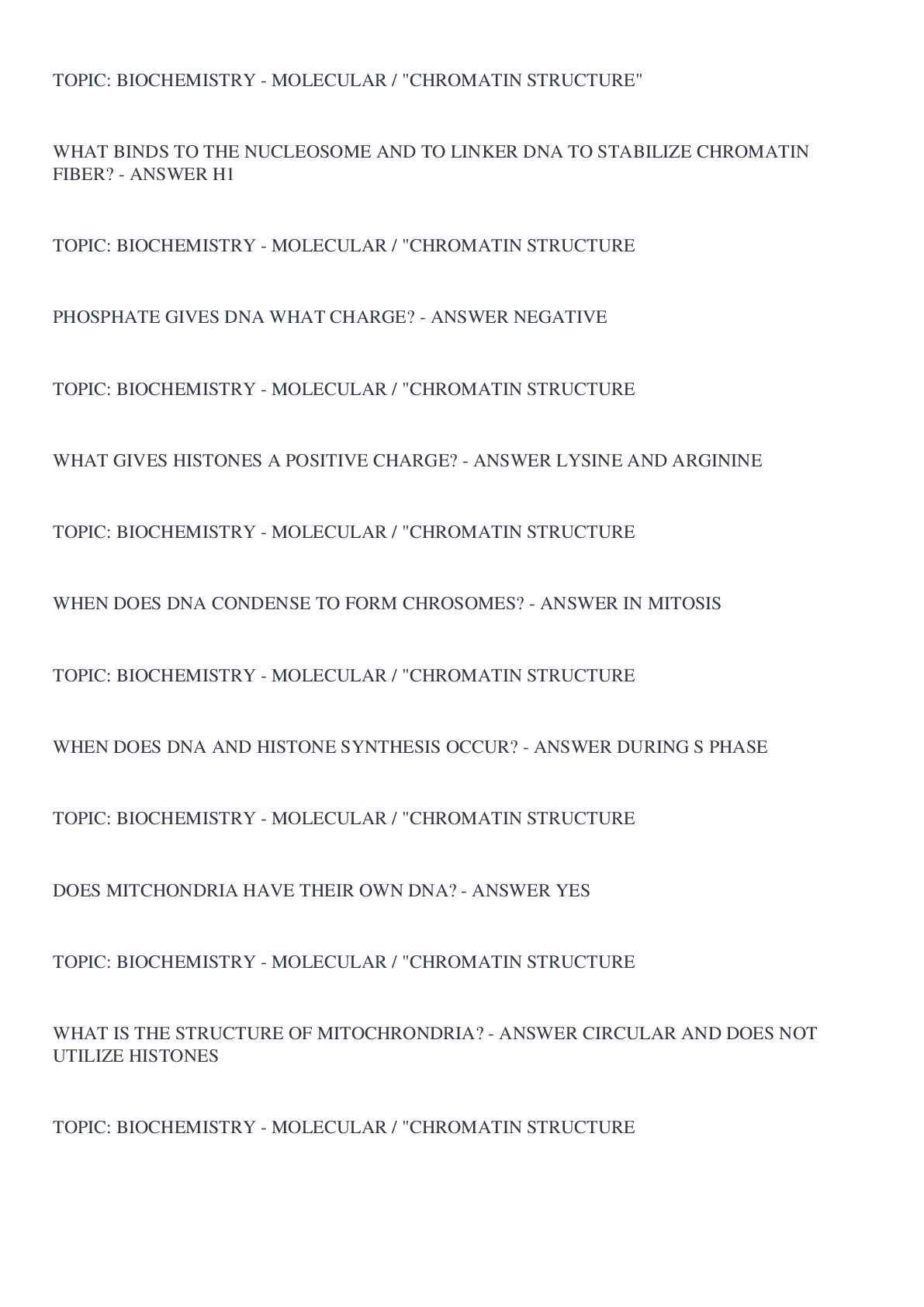
.png)
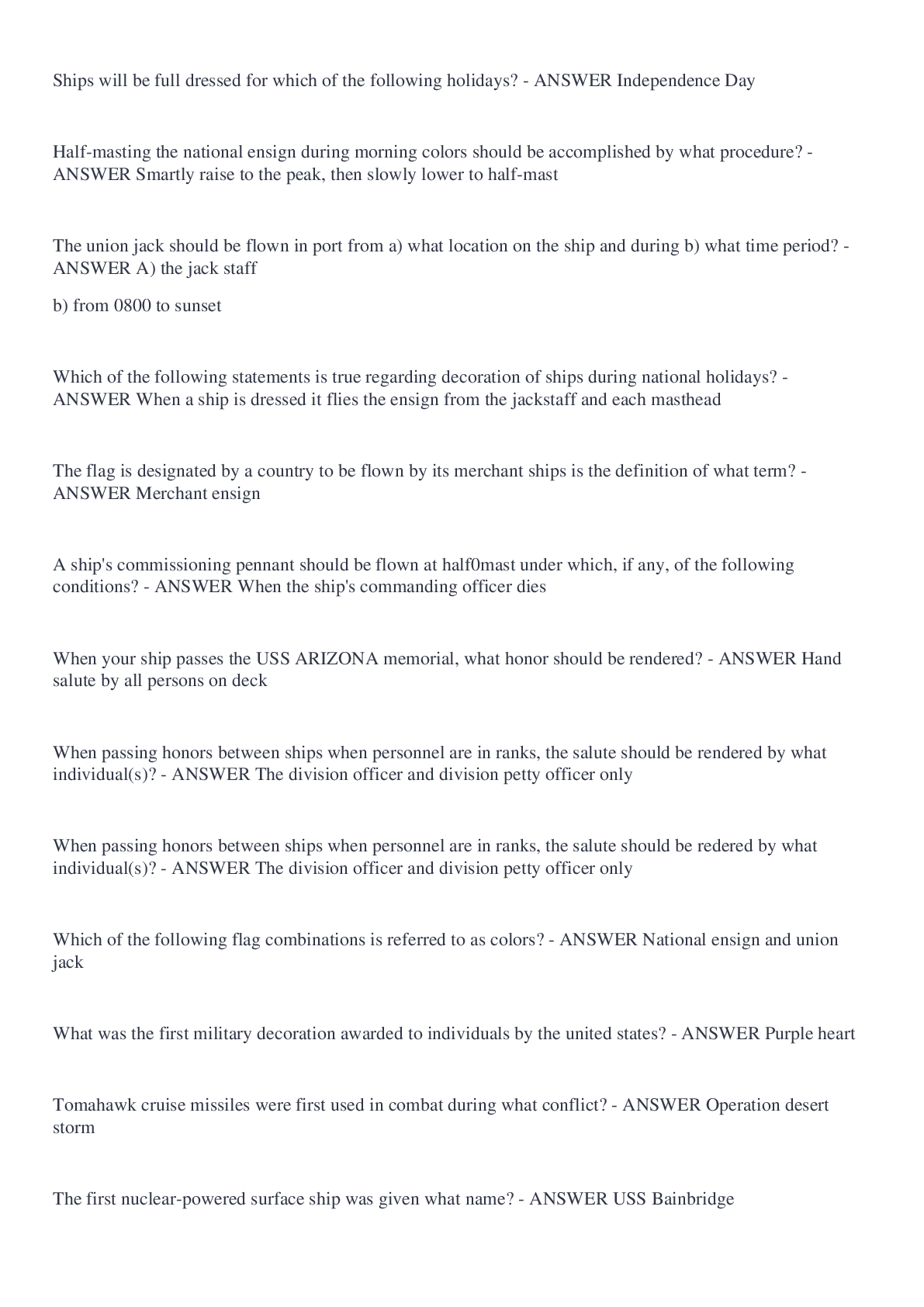
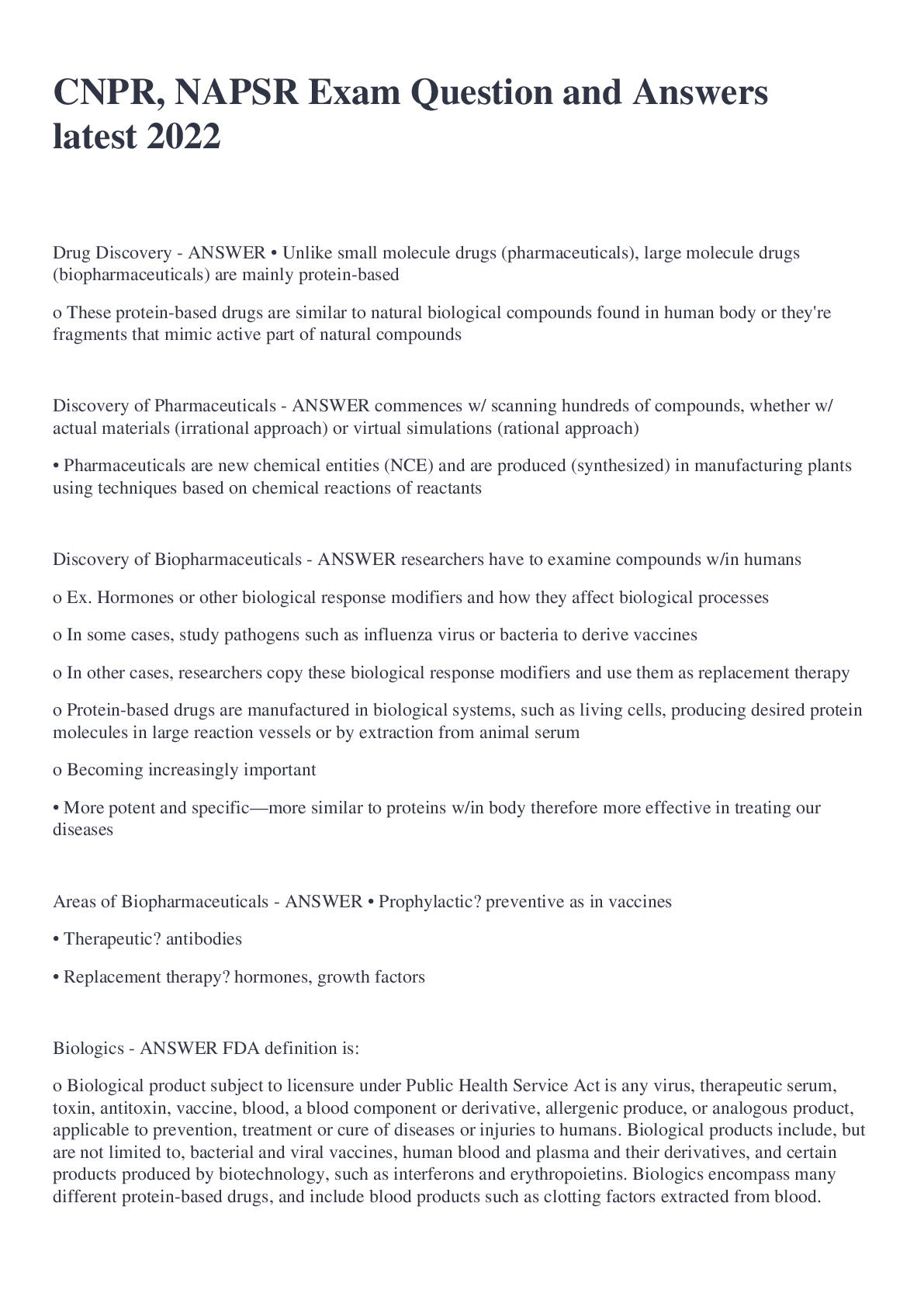

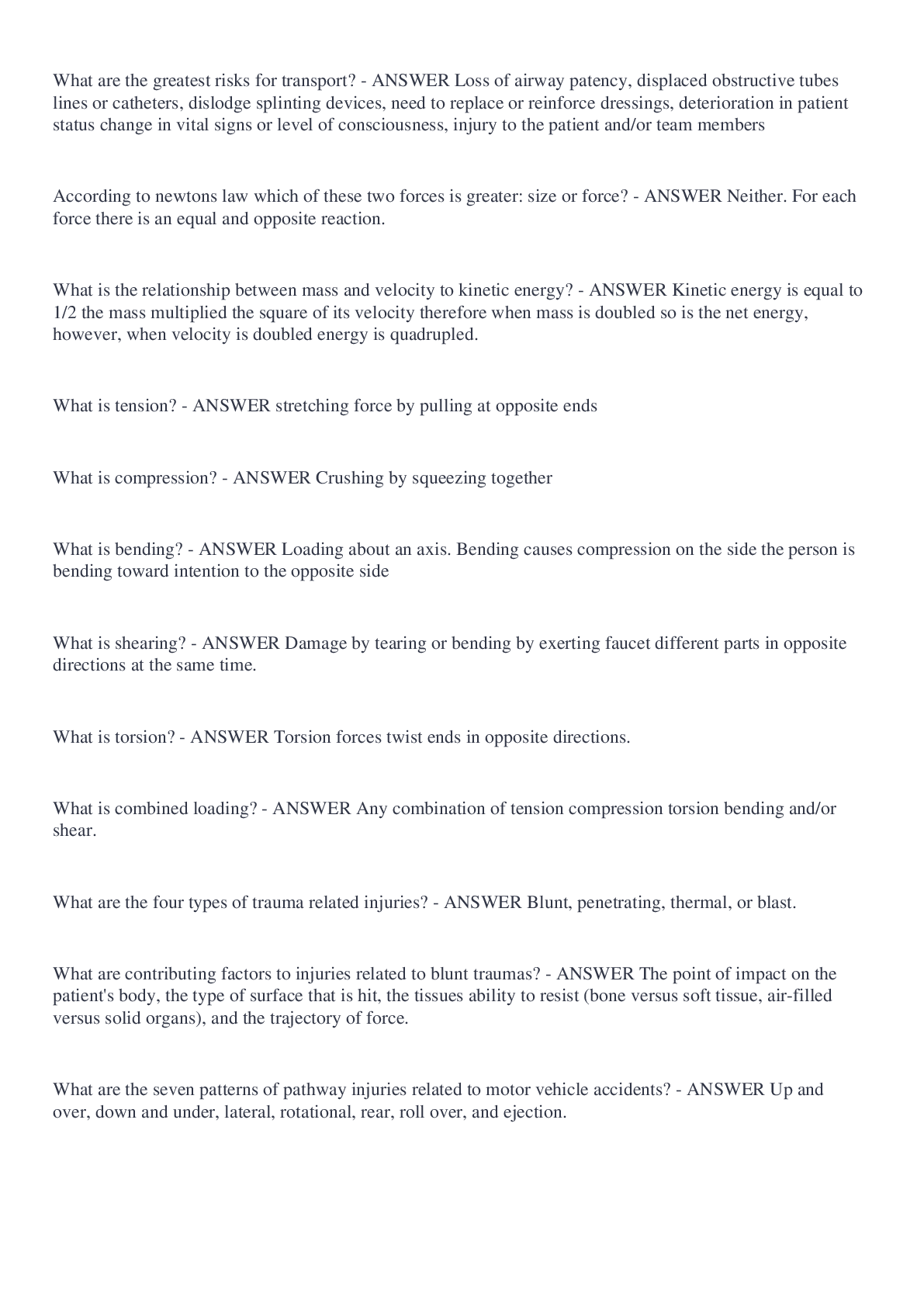

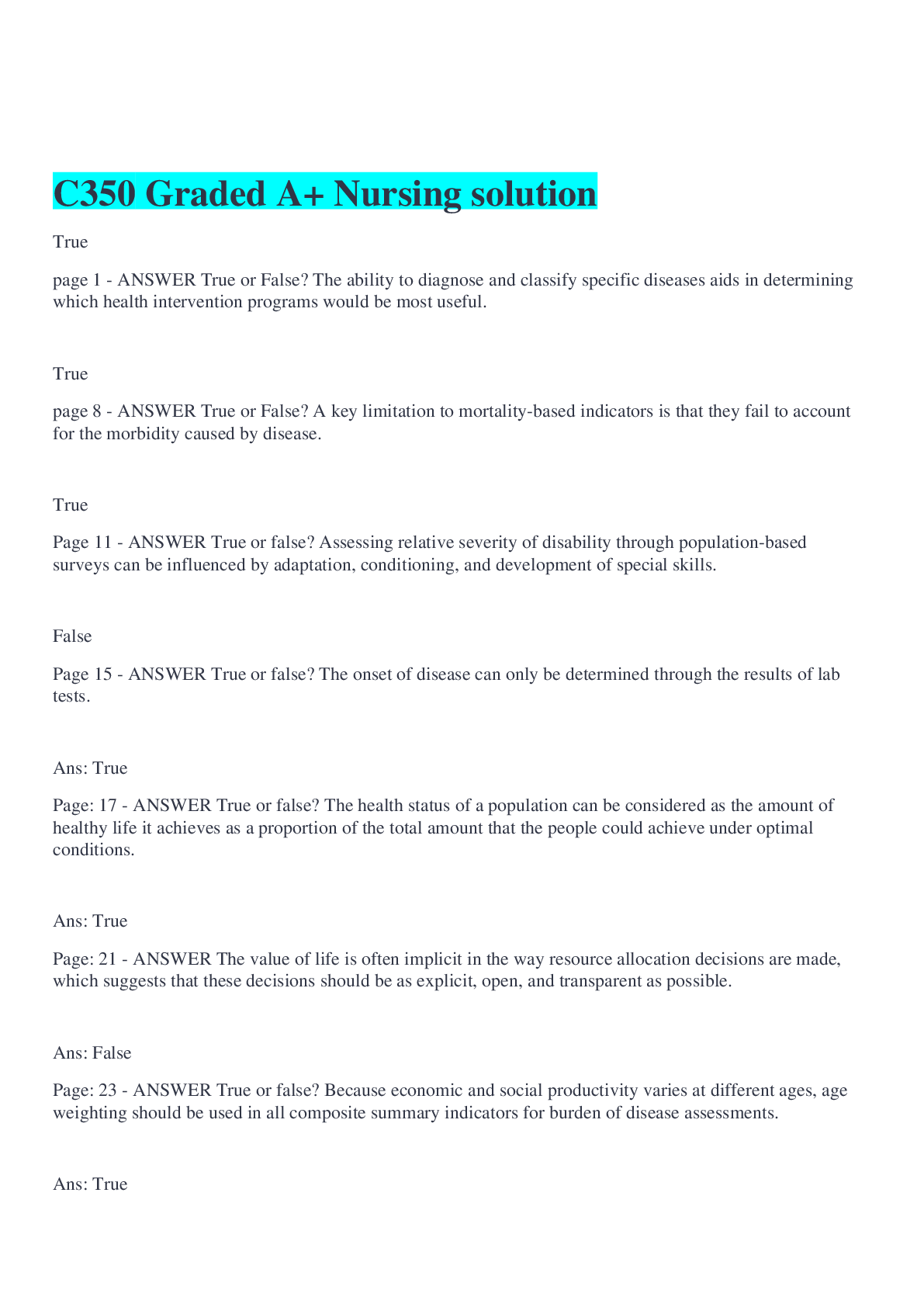
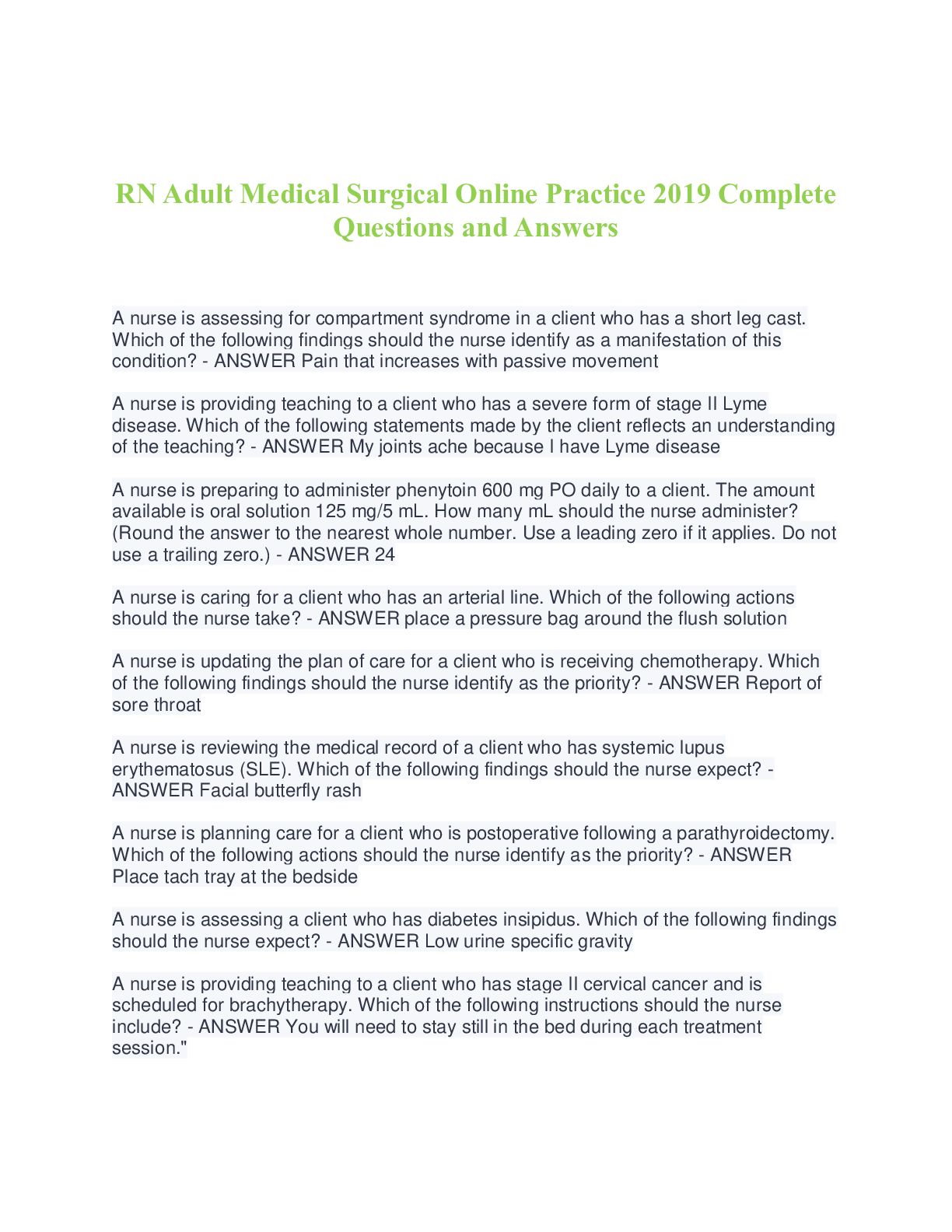

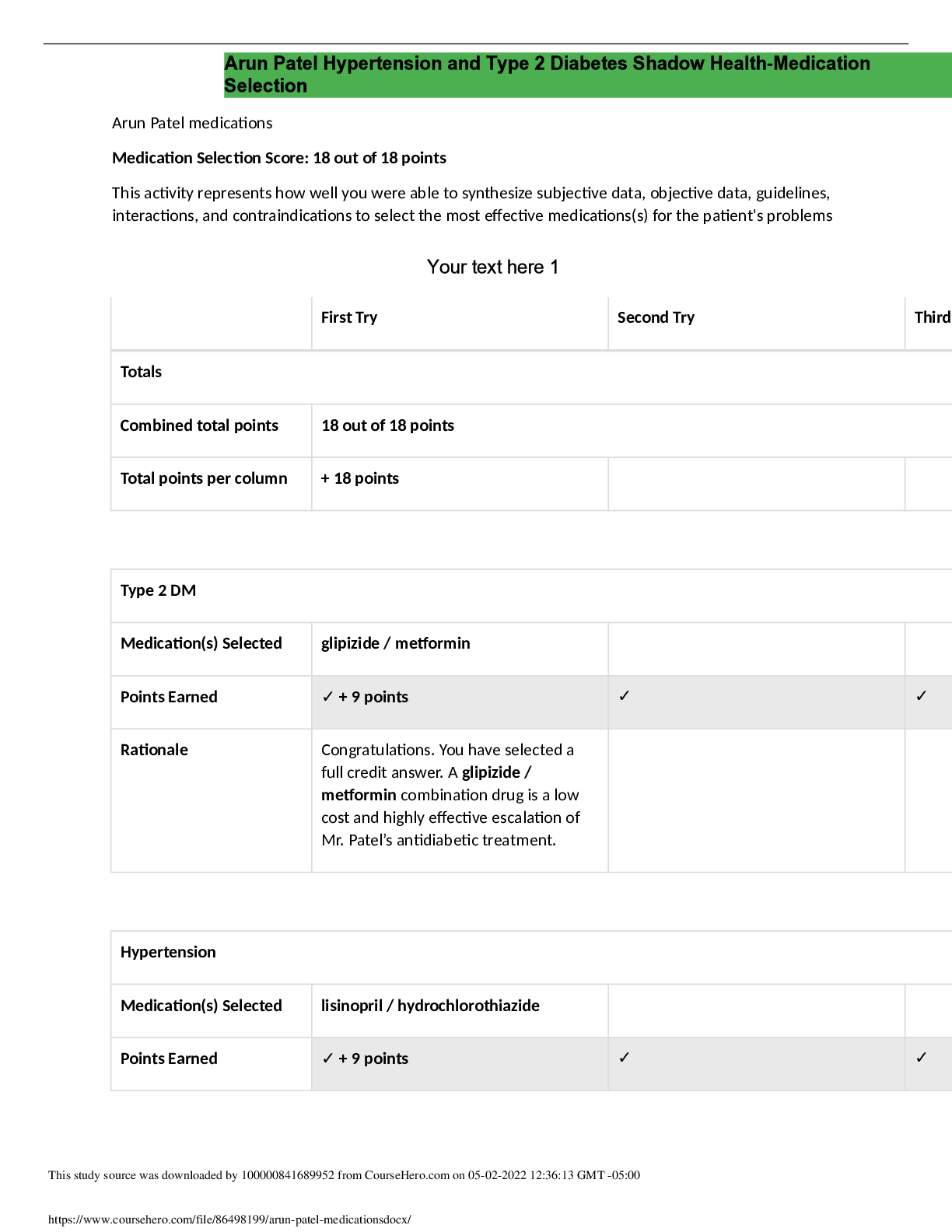

.png)
.png)

